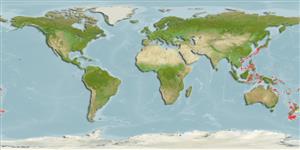Classification / Names
Common names | Synonyms | Catalog of Fishes (gen., sp.) | ITIS | CoL | WoRMS | Cloffa
Elasmobranchii (sharks and rays) >
Carcharhiniformes (Ground sharks) >
Scyliorhinidae (Cat sharks)
Etymology: Cephaloscyllium: Greek, kephale = head + skylion = dogfish (Ref. 80388); signourum: Name from Latin 'signum' for flag and the Greek 'oura' for tail, refers to the
distinctive flag-like dark marking on the terminal lobe of the caudal fin.. More on author: Last.
Environment / Climate / Range
Ecology
Marine; benthopelagic; depth range 480 - 700 m (Ref. 76946). Tropical, preferred ?
Western Pacific: Australia; possibly occurring off the islands of New Caledonia, Fiji, and Vanuatu.
Size / Weight / Age
Maturity: Lm ? range ? - ? cm
Max length : 74.1 cm TL (female)
Short description
Morphology | Morphometrics
This medium-sized species has the following set of characters which was based on the holotype: head 7.5% TL in height, trunk 16.3% TL in width; origin of first dorsal-fin is over the anterior pelvic-fin base; prenarial 3.6% TL in length; preorbital snout length is 2.0 times prenarial length, 3.0 in prepectoral length, 6.6 in prepelvic length; snout-vent length long, 51.7% TL; nostril width 2.7% TL; eye-spiracle space narrow, 0.5% TL; pectoral fin medium-sized, its height 12.8% TL, posterior margin 11.9% TL; anal fin tall, 4.0% TL; anal-caudal space is 5.0% TL; precaudal length is 76% TL; interdorsal space is 6.6% TL; teeth with 3 well-developed cusps near symphysis of upper jaw; mostly unicuspidate flank denticles; back without the greatly enlarged denticles; adult clasper unknown; vertebral centra 115-116; tooth count high, 84 teeth in upper jaws, 97 in lower jaws; color of upper half of body medium brown, with a variegated pattern that is not clearly demarcated from the ventral surface; dark saddles (10) evident on body and tail; dorsal fins are pale variegated; dark blotch absent over gills; marking on posterior margin of terminal lobe of caudal fin dark, anteriorly directed, V-shaped; upper surface of pectoral-fin with a dark brown central blotch; centered over ventral origin of caudal fin is a well-developed saddle; ventral surface is uniformly greyish or white in color; juveniles are pale with dark transverse markings appearing as narrow bars and hollow saddles; markings between spiracles not separated into two unconnected pseudo-ocelli (Ref. 76946).
Life cycle and mating behavior
Maturity | Reproduction | Spawning | Eggs | Fecundity | Larvae
Last, P.R., B. Séret and W.T. White, 2008. New swellsharks (Cephaloscyllium: Scyliorhinidae) from the Indo-Australian region. In Last, P.R., White, W.T. & Pogonoski, J.J. (eds.): Descriptions of New Australian Chondrichthyans. CSIRO Marine and Atmospheric Research Paper no. 22. (Ref. 76946)
IUCN Red List Status (Ref. 115185)
CITES (Ref. 94142)
Not Evaluated
Threat to humans
Harmless
Human uses
More information
Common namesSynonymsMetabolismPredatorsEcotoxicologyReproductionMaturitySpawningFecundityEggsEgg development
Age/SizeGrowthLength-weightLength-lengthLength-frequenciesMorphometricsMorphologyLarvaeLarval dynamicsRecruitmentAbundance
ReferencesAquacultureAquaculture profileStrainsGeneticsAllele frequenciesHeritabilityDiseasesProcessingMass conversion
Tools
Special reports
Download XML
Internet sources
Estimates of some properties based on models
Phylogenetic diversity index (Ref.
82805): PD
50 = 0.5000 [Uniqueness, from 0.5 = low to 2.0 = high].
Bayesian length-weight: a=0.00324 (0.00157 - 0.00666), b=3.11 (2.93 - 3.29), in cm Total Length, based on LWR estimates for this (Sub)family-body shape (Ref.
93245).
Trophic Level (Ref.
69278): 4.1 ±0.5 se; Based on size and trophs of closest relatives
Resilience (Ref.
69278): Low, minimum population doubling time 4.5 - 14 years (Preliminary K or Fecundity.).
Vulnerability (Ref.
59153): High vulnerability (56 of 100) .
